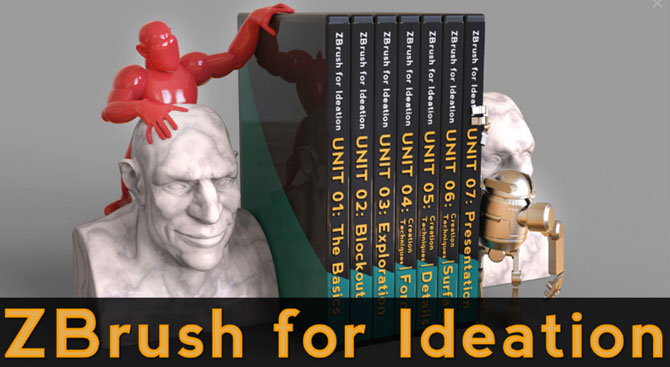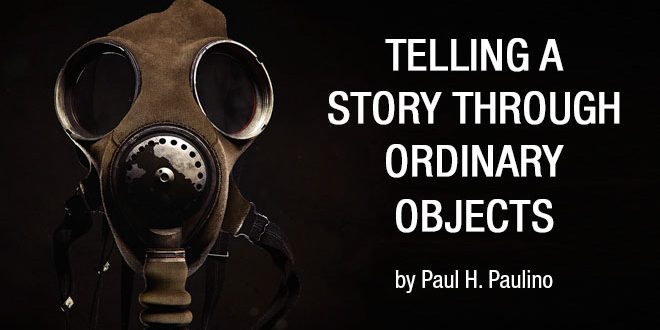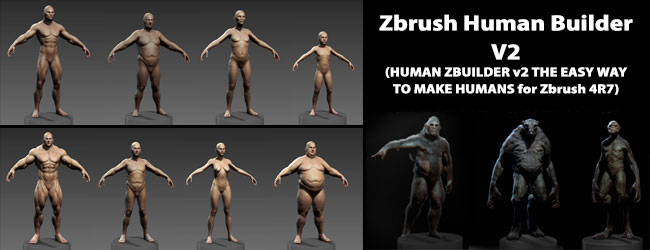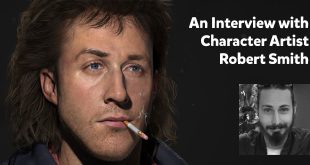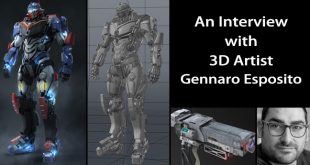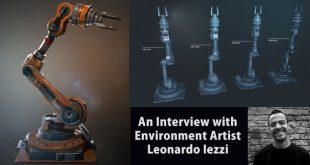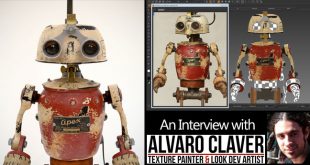TELLING A STORY THROUGH ORDINARY OBJECTS by Paul H. Paulino
PAUL H. PAULINO is a Texture Painter/Look Development Artist at Scanline VFX from Vancouver, Canada. Paul shared his latest article with zbrushtuts.com. Hope you liked it and will be inspiring.
When I finally got my interview for a position as a Junior Texture Artist/Look Development artist at Scanline VFX, I only had one piece in my reel, a World War II Gas Mask. If you had seen me on that day, you would have thought that I was the most confident guy ever.
I was indeed confident, but deep inside I was afraid they were not going to like my portfolio because it was just “too simple”.
The interview only took fifteen minutes, after which I left the room with a big smile. They didn’t give me an answer that day, as to whether or not I’d gotten the job, but I knew that I’d landed the position.. They loved my mask. But why?
In this article, I’m going to share my thoughts and personal experience to help you understand that even an ordinary object can become a beautiful portfolio piece, when it’s presented with a hyper-realistic quality.
I’m going to be focusing on texturing/lookdev because this is my expertise, but I hope the principles I’m talking about here can be useful for other specialties as well.
Let’s get started::
KEEP IT SIMPLE
As I mentioned at the beginning of the article, I wasn’t sure if my reel was good enough. I was afraid that they were expecting character work or even a massive scene with multiple objects. But the thing is, when I started working at Scanline I realized that most of the entry level work consists of texturing small props.
Screenshot from Justice League (2017) trailer – Ezra knows what we are talking about here!
Unfortunately, if you never had a previous experience in the VFX industry, it is unlikely that you’re going to have a hero prop or character right away. Even if you have shown incredible skills in your reel, they will ask you to start small. And to be honest, it makes sense right? Your student reel might be good, but it doesn’t show that you know how to work in a studio setting and deal with reviews, deadlines, etc.
Don’t get me wrong; I’m not trying to discourage you if you want to have a character/creature in your student reel. I’m just saying, be honest with yourself and if you are not sure that it is possible to make an incredibly realistic character or creature for your reel, don’t be intimidated.
It may be better to keep it simple and choose an interesting prop and to make it as realistic as you can. In my opinion, it is better to have an object with outstanding textures and materials than an organic piece poorly executed.
Also, don’t think that just because your reel doesn’t have a character/creature, it means that you’re never going to make one. When I started at Scanline, I learned so much from my friends and after a few months I was able to finish my first organic asset, The Southern Cassowary.
I know that if I had finished this piece back in school, it would have taken me forever to get it done, and it wouldn’t be as good as the final version.
WHAT THE VFX INDUSTRY IS LOOKING FOR?
To endorse the things I mentioned above, I asked two friends and experienced VFX artists that had the opportunity to choose and judge entry level candidates in the past to explain what they are looking for when they see a student reel.
“I am looking for entry level texture painters to submit work that demonstrates a clear understanding of surface qualities with a keen eye for detail. Sometimes simplifying the asset allows you to spend more on the areas that matter. The saying “go big or go home” does not apply here. Remaining conservative with the type of assets you choose will allow you to focus more of your time on that last 10% that most students miss.”
— Justin Holt
Justin Holt is currently the Texture Paint Supervisor at Sony Pictures Imageworks. He was also my mentor at Think Tank Training Centre.
“When I’m reviewing texturing demo reels for an entry level position, all I’m looking for is someone that can show that can reproduce something from real life. It doesn’t have to be a complicated character or heavily detailed model, it just has to show a good understanding of the texture maps needed to make the material surfaces look realistic.”
— Alwyn Hunt
Alwyn Hunt is the co-founder of The Rookies and a former Senior Texture Painter at Weta Digital.
I also want to share 3D artworks from friends that are currently working in the industry and got their first job with “ordinary” objects showcasing outstanding realistic textures and materials:
Ps.: Christian has an organic asset on his reel which he finished after he started working in the industry.
Christian is currently a Texture Painter at Digital Domain. Check out Christian’s website.
Hugh is currently a 3D Generalist at Scanline VFX. Check out Hugh’s website.
CASE STUDY – THE GUMBALL MACHINE
One day I decided to start a new personal project, but I didn’t have any ideas. I wanted to create something simple, but with a strong emotional connection.
I woke up in the middle of that night and had an idea. I was searching for one of my favorites art books of all time: Color and Light by James Gurney. To be honest, I wasn’t sure of what I was looking for when flipping through the pages, but then I found the gumball machine.
It was wonderful. I remember looking at this painting being mesmerized not only by the artwork itself, which was incredible but also by the amazing potential that it has. I was really excited about it, and I was even more excited when I found Gurney’s blog.
There he had an article talking about his experience painting his piece. He tells a funny story about his kid that used the gumball machine while he was painting it, changing the gumballs position and messing with his artwork.
I was excited to find a painting with such an amazing story behind it, so I decided to recreate that same gumball with realistic textures and shaders. It sounded easy enough for me to recreate it, I mean, it was just metal, plastic, glass and a simple shader for the gumballs.
But I wanted to go further and add a story to it; I wanted that someone would look at it and think about childhood moments and somehow create an emotional connection with my artwork.
So I decided to learn more about gumball machines.
Source: Flickr – Photo by Robert Fairchild
It might sound silly, but I went to several places just to buy gumballs and take photos of gumball machines around the city. I tried to buy one, trust me, but they were going to be too new, and I couldn’t find a used version. So I took photos, videos and everything that I could to help me with the creation process.
After collecting all the information that I could about the machine, I modeled it and then started the texturing process.
Within the process, I thought about Gurney’s story with the kid, and I was thinking in a way to incorporate that into my artwork. So I decided to add fingerprints and smudges, thinking about the idea of kids putting their hands all over the machine to find their favorite gumball.
I saw that happening when I was taking my reference photos, and it was an interesting story to tell.
And finally, to incorporate another layer of storytelling I added a sticker glue residue on the side of the machine. I thought that maybe someone had put a sticker there and then a kid might had taken it off.
Aside from the details to make the gumball look realistic, I also wanted to do an homage to James Gurney. He is such an amazing artist and inspired not only me but so many artists around the world, that I thought it was going to be a good idea to mention him or his work somehow.
So I decided to put the name of his book, the same one that inspired me to create the piece, on the sticker.
And even though I knew nobody would see it, I also put his name on the gumballs logos. I used the same design that the original gumballs had and changed the name to “Gurney Bubble”.
I was happy with the final result, and I decided to publish it online to get some feedback. I wasn’t expecting a lot of attention because it was “just an ordinary object.”, but to my surprise, it was extremely well received by the community.
Intrigued by that reaction, I asked some people why they liked the artwork and some of them related that the gumball reminded them of their childhood.
I was happy and I realized that I’d accomplished my goal. I told a story with my “ordinary” object.
FINAL THOUGHTS
I hope you found this article useful. I wanted to show you that storytelling can be used everywhere, even when you’re texturing props that you see everyday.
Every used object has a story to tell, and it is our job to translate that into our models, textures and materials. As I like to say to my students: “If you treat your props as if they are small story books, your results are going to be incredible.”
So if you are working on something now, which story you want to tell? Send me an email or contact me through Facebook/Twitter with your tale; I would love to know. 🙂
If you enjoyed reading this article, don’t forget to share it with your friends. And if you are interested in more content like that in the future, make sure to sign up in my newsletter below at:
Website: http://www.paulhpaulino.com/
Facebook: https://www.facebook.com/paulhpaulino
Artstation: https://www.artstation.com/artist/paulhpaulino/profile
 zbrushtuts Zbrush Tutorials, Art and Breakdowns
zbrushtuts Zbrush Tutorials, Art and Breakdowns


